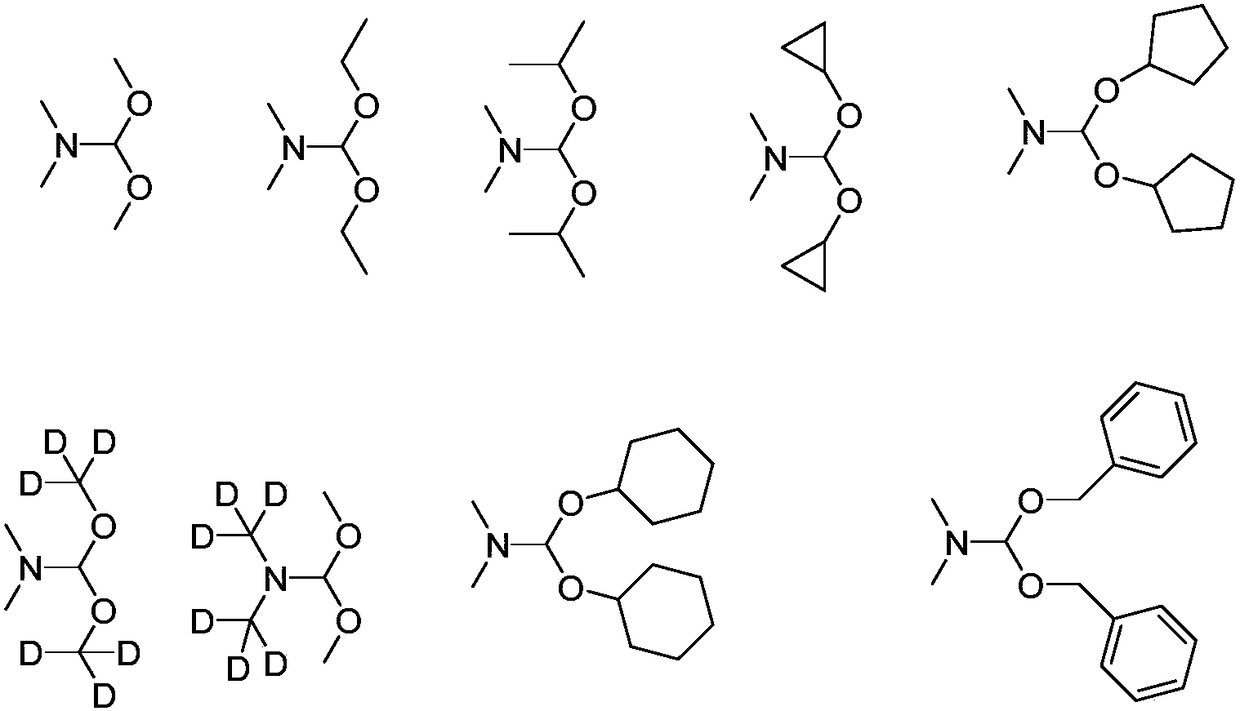Alkylation method for nitrogen-hydrogen containing compounds and application thereof
A technology of compound and alkylation, which is applied in the preparation of organic compounds, preparation of amino compounds, chemical instruments and methods, etc., can solve problems that have not been reported in the research, and achieve high reaction efficiency, mild reaction conditions and high tolerance Effect
- Summary
- Abstract
- Description
- Claims
- Application Information
AI Technical Summary
Problems solved by technology
Method used
Image
Examples
Embodiment 1
[0030] Example 1 Preparation of 1-methyl-3,4-dihydroquinazolin-2(1H)-one
[0031]
[0032] To 3,4-dihydroquinazolin-2(1H)-one (1.7g, 11.6mmol) in DMF solution (10ml) was added dropwise N,N-dimethylformamide dimethyl acetal (5.5 g, 46.3mmol), react at 80°C for 2h. Water (28ml) and ethyl acetate (15ml) were added to separate the layers, the aqueous layer was extracted with ethyl acetate (15×2ml), the organic layers were combined, washed with saturated brine, dried over anhydrous sodium sulfate, filtered, and the filtrate was decompressed Concentrate to obtain a crude product, which is separated by column chromatography (eluent: petroleum ether: ethyl acetate = 10:1) to obtain 1.6 g of white solid, which is relative to 3,4-dihydroquinazoline-2(1H)- The yield of ketone is 91.8%. The purity of the product is 99.6% (mass fraction), MS (ESI) (m / z): 161.2 (M+H) + . 1 H-NMR(CDCl 3 , 400MHz) δ: 7.15 (m, 1H), 7.08-7.11 (m, 2H), 6.93 (m, 1H), 3.42 (s, 3H), 2.86 (t, 2H), 2.49 (t, 2H).
Embodiment 2
[0033] Example 2 Preparation of 1-ethyl-3,4-dihydroquinazolin-2(1H)-one
[0034]
[0035] To 3,4-dihydroquinazolin-2(1H)-one (0.3g, 2.0mmol) in DMF solution (4ml) was added dropwise N,N-dimethylformamide diethyl acetal (1.0 g, 8.2mmol), react at 80°C for 2h. Add water (10ml) and ethyl acetate (10ml), separate the layers, extract the aqueous layer with ethyl acetate (10×2ml), combine the organic layers, wash with saturated brine, dry with anhydrous sodium sulfate, filter, and reduce the filtrate Concentrate to obtain a crude product, which is separated by column chromatography (eluent: petroleum ether: ethyl acetate = 10:1) to obtain a white solid (0.32 g, yield 89.8%). The purity of the product is 99.4% (mass fraction), MS (ESI) (m / z): 175.1 (M+H) + . 1 H-NMR(CDCl 3 , 400MHz) δ: 7.15 (m, 1H), 7.08-7.11 (m, 2H), 6.93 (m, 1H), 4.42 (m, 2H), 2.86 (t, 2H), 2.49 (t, 2H), 1.49 (t,3H).
Embodiment 3
[0036] Example 3 Preparation of 1-isopropyl-3,4-dihydroquinazolin-2(1H)-one
[0037]
[0038] To 3,4-dihydroquinazolin-2(1H)-one (0.7g, 4.7mmol) in DMF solution (4ml) was added dropwise N,N-dimethylformamide diisopropyl acetal ( 3.2g, 27.2mmol), reacted at 80°C for 2h. Add water (18ml) and ethyl acetate (15ml), separate the layers, extract the aqueous layer with ethyl acetate (15×2ml), combine the organic layers, wash with saturated brine, dry with anhydrous sodium sulfate, filter, and reduce the filtrate Concentrate to obtain a crude product, which is separated by column chromatography (eluent: petroleum ether: ethyl acetate = 10:1) to obtain a white solid (0.75 g, yield 84.2%). The purity of the product is 99.5% (mass fraction), MS (ESI) (m / z): 189.1 (M+H) + . 1 H-NMR(CDCl 3 , 400MHz) δ: 7.15 (m, 1H), 7.08-7.11 (m, 2H), 6.93 (m, 1H), 3.80 (m, 1H), 2.86 (t, 2H), 2.49 (t, 2H), 1.32 (d, 6H).
PUM
 Login to View More
Login to View More Abstract
Description
Claims
Application Information
 Login to View More
Login to View More - R&D
- Intellectual Property
- Life Sciences
- Materials
- Tech Scout
- Unparalleled Data Quality
- Higher Quality Content
- 60% Fewer Hallucinations
Browse by: Latest US Patents, China's latest patents, Technical Efficacy Thesaurus, Application Domain, Technology Topic, Popular Technical Reports.
© 2025 PatSnap. All rights reserved.Legal|Privacy policy|Modern Slavery Act Transparency Statement|Sitemap|About US| Contact US: help@patsnap.com



